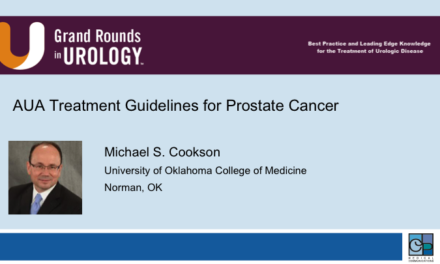Dr. Erik P. Castle spoke at the 23rd annual Perspectives in Urology Point • Counterpoint meeting on Saturday, November 15, 2014 on “Novel Secondary Hormonal Therapies for Prostate Cancer.”
Keywords: novel secondary hormonal therapies, prostate cancer
How to cite: Castle, Erik P. “Novel Secondary Hormonal Therapies for Prostate Cancer” Grand Rounds in Urology. August 13, 2015. Accessed Apr 2024. https://grandroundsinurology.com/prostate-cancer-erik-p-castle-novel-secondary-hormonal-therapies-for-prostate-cancer/.
References
Bosland MC, Ford H, Horton L. Induction at high incidence of ductal prostate adenocarcinomas in NBL/Cr and Sprague-Dawley Hsd:SD rats treated with a combination of testosterone and estradiol-17 beta or diethylstilbestrol. Carcinogenesis. 1995 Jun;16(6):1311-7.
http://www.ncbi.nlm.nih.gov/pubmed/7788848
Chan PS, Chan LW, Xuan JW, et al. In situ hybridization study of PSP94 (prostatic secretory protein of 94 amino acids) expression in human prostates. Prostate. 1999 Oct 1;41(2):99-109.
http://www.ncbi.nlm.nih.gov/pubmed/10477906
Debes JD, Tindall DJ. Mechanisms of androgen-refractory prostate cancer. N Engl J Med. 2004 Oct 7;351(15):1488-90.
http://www.ncbi.nlm.nih.gov/pubmed/15470210
de Jong FH, Oishi K, Hayes RB, et al. Peripheral hormone levels in controls and patients with prostatic cancer or benign prostatic hyperplasia: results from the Dutch-Japanese case-control study. Cancer Res. 1991 Jul 1;51(13):3445-50.
http://www.ncbi.nlm.nih.gov/pubmed/1711411
Fowler KA, Gill K, Kirma N, et al. Overexpression of aromatase leads to development of testicular leydig cell tumors : an in vivo model for hormone-mediated TesticularCancer. Am J Pathol. 2000 Jan;156(1):347-53.
http://www.ncbi.nlm.nih.gov/pubmed/10623684
Ghatak S, Ho SM. Age-related changes in the activities of antioxidant enzymes and lipid peroxidation status in ventral and dorsolateral prostate lobes of noble rats. Biochem Biophys Res Commun. 1996 May 15;222(2):362-7.
http://www.ncbi.nlm.nih.gov/pubmed/8670210
Gleave M, Evans CP. What’s hot in the prostate? Prostate Cancer Prostatic Dis. 2004;7(4):273-6.
http://www.ncbi.nlm.nih.gov/pubmed/15592439
Hewitt SC, Harrell JC, Korach KS. Lessons in estrogen biology from knockout and transgenic animals. Annu Rev Physiol. 2005;67:285-308.
http://www.ncbi.nlm.nih.gov/pubmed/15709960
Ho SM, Leav I, Ghatak S, et al. Lack of association between enhanced TRPM-2/clusterin expression and increased apoptotic activity in sex-hormone-induced prostatic dysplasia of the Noble rat. Am J Pathol. 1998 Jul;153(1):131-9.
http://www.ncbi.nlm.nih.gov/pubmed/9665473
Kaplan PJ, Leav I, Greenwood J, et al. Involvement of transforming growth factor alpha (TGFalpha) and epidermal growth factor receptor (EGFR) in sex hormone-induced prostatic dysplasia and the growth of an androgen-independent transplantable carcinoma of the prostate. Carcinogenesis. 1996 Dec;17(12):2571-9.
http://www.ncbi.nlm.nih.gov/pubmed/9006091
Lam JS, Leppert JT, Vemulapalli SN, et al. Secondary hormonal therapy for advanced prostate cancer. J Urol. 2006 Jan;175(1):27-34.
http://www.ncbi.nlm.nih.gov/pubmed/16406864
Li L, Seno M, Yamada H, Kojima I. Promotion of beta-cell regeneration by betacellulin in ninety percent-pancreatectomized rats. Endocrinology. 2001 Dec;142(12):5379-85.
http://www.ncbi.nlm.nih.gov/pubmed/11713238
McPherson SJ, Wang H, Jones ME, et al. Elevated androgens and prolactin in aromatase-deficient mice cause enlargement, but not malignancy, of the prostate gland. Endocrinology. 2001 Jun;142(6):2458-67.
http://www.ncbi.nlm.nih.gov/pubmed/11356695
Migliaccio A, Castoria G, Di Domenico M, et al. Crosstalk between EGFR and extranuclear steroid receptors. Ann N Y Acad Sci. 2006 Nov;1089:194-200.
http://www.ncbi.nlm.nih.gov/pubmed/17261767
Montano MM, Deng H, Liu M, et al. Transcriptional regulation by the estrogen receptor of antioxidative stress enzymes and its functional implications. Oncogene. 2004 Apr 1;23(14):2442-53.
http://www.ncbi.nlm.nih.gov/pubmed/14676828
Ross R, Bernstein L, Judd H, et al. Serum testosterone levels in healthy young black and white men. J Natl Cancer Inst. 1986 Jan;76(1):45-8.
http://www.ncbi.nlm.nih.gov/pubmed/3455741
Signoretti S, Loda M. Estrogen receptor beta in prostate cancer: brake pedal or accelerator? Am J Pathol. 2001 Jul;159(1):13-6.
http://www.ncbi.nlm.nih.gov/pubmed/11438447
Tam NN, Gao Y, Leung YK, Ho SM. Androgenic regulation of oxidative stress in the rat prostate: involvement of NAD(P)H oxidases and antioxidant defense machinery during prostatic involution and regrowth. Am J Pathol. 2003 Dec;163(6):2513-22.
http://www.ncbi.nlm.nih.gov/pubmed/14633623
Yu M, Cates J, Leav I, Ho SM. Heterogeneity of [3H]estradiol binding sites in the rat prostate: properties and distribution of type I and type II sites. J Steroid Biochem. 1989 Sep;33(3):449-57.
http://www.ncbi.nlm.nih.gov/pubmed/2779236



